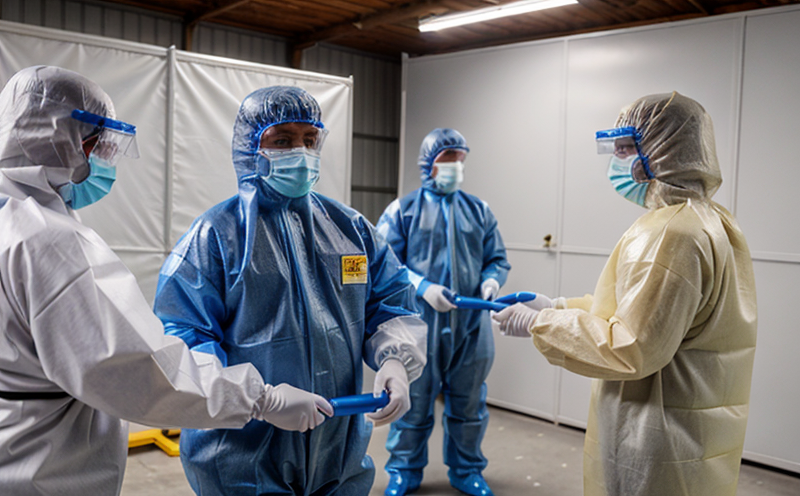ISO 16602 Chemical protective apparel Classification and performance
The ISO 16602 standard provides a framework for the classification of chemical protective clothing, ensuring that such garments offer adequate protection against various hazardous chemicals. This service is critical in sectors like manufacturing, healthcare, and emergency response where workers are exposed to potentially harmful chemicals.
ISO 16602 outlines detailed criteria for evaluating the performance characteristics of chemical protective apparel. These include resistance to penetration by specific chemicals, breathability, thermal stability, and physical properties such as tensile strength and tear resistance. The classification system is based on these parameters, enabling users to select appropriate garments that meet their specific safety needs.
The testing process involves rigorous evaluation of the protective clothing under controlled conditions. Specimens are subjected to standardized tests to measure their resistance to various chemicals. This includes immersion tests where the fabric is exposed directly to a chemical, and air permeation tests which assess how effectively the garment prevents the passage of hazardous materials through its structure.
Preparation of specimens for testing is crucial and involves careful handling to ensure accurate results. The samples are cut from the garments according to specified dimensions and weights, ensuring that they represent typical areas where chemicals might come into contact with workers' skin.
The equipment used in these tests includes immersion chambers, air permeation apparatuses, and various chemical reagents. These tools allow for precise measurement of how effectively the protective clothing protects against different types of hazardous substances. The results are then analyzed according to the ISO 16602 guidelines to determine the appropriate classification level.
Classification levels range from A to F, with increasing levels of protection. This allows employers and workers to choose garments that match their specific work environments and risks. For instance, a garment classified as Level E would offer higher resistance than one classified as Level D.
The importance of this standard cannot be overstated in ensuring worker safety. By providing clear guidelines for the classification and performance evaluation of chemical protective clothing, ISO 16602 helps prevent accidents and injuries caused by improper protection.
Our laboratory adheres strictly to these standards, ensuring accurate and reliable testing results. We use state-of-the-art equipment and employ highly skilled technicians who are well-versed in the intricacies of this standard.
Applied Standards
| Standard Number | Description |
|---|---|
| ISO 16602-1 | Classification of chemical protective clothing - Part 1: General requirements and classification criteria |
| ISO 16602-2 | Classification of chemical protective clothing - Part 2: Test methods for chemical resistance and permeation |
| ISO 16602-3 | Classification of chemical protective clothing - Part 3: Determination of physical properties |
The ISO 16602 series of standards is comprehensive, covering various aspects of chemical protective clothing. These parts work together to provide a holistic approach to the classification and performance evaluation of these garments.
Eurolab Advantages
At Eurolab, we pride ourselves on offering top-tier testing services that meet or exceed international standards. Our team is dedicated to ensuring that every test conducted adheres strictly to the ISO 16602 guidelines.
We have state-of-the-art facilities equipped with the latest technology and experienced personnel who are trained in conducting these tests accurately and efficiently. This ensures that our clients receive reliable, accurate results.
Our commitment to quality extends beyond just meeting standards; we also offer additional services such as consultation on garment design, safety audits, and training programs aimed at enhancing worker safety.
We understand the importance of timely delivery and strive to ensure that all tests are completed swiftly without compromising on accuracy. This allows our clients to make informed decisions promptly based on our findings.
Environmental and Sustainability Contributions
The protection provided by chemical protective clothing is essential for workers in high-risk environments, but it also has broader implications for environmental sustainability. By ensuring that workers are adequately protected against hazardous substances, we can reduce the likelihood of accidental spills or releases into the environment.
Our testing services play a crucial role in promoting sustainable practices within industries where chemical protective clothing is used. Through rigorous evaluation and certification processes, we help manufacturers produce garments that are both effective and environmentally friendly.
In addition to protecting workers, our services contribute to reducing waste by ensuring that only the most appropriate and necessary protective gear is procured. This helps minimize the environmental impact associated with over-provisioning or unnecessary purchases of such equipment.





